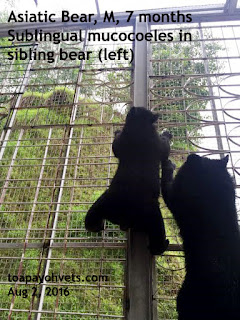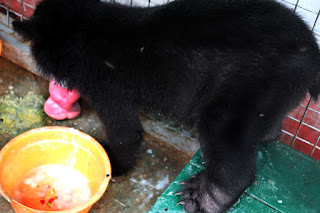HOOK
Around January 2016, in the jungles of central Myanmar, a mother bear rushed out as the poachers came nearer. She stepped onto a bear trap and was shot. Her 2 bear cubs dashed deep into the forests. These one-month-old cubs were worth a fortune to the poachers as pets in private zoos.
AUDIO. Sounds of gun-fire from youtube free audio
Villagers brought them to a monastery where they would be safe. (VIDEO. Thabarwa Center)
Two siblings. One had two tongue growths under the tongue. At first they were small soft cysts filled with liquid. They were the size of a fish ball. Over the next 4 months, they expanded to be bigger than golf balls. The affected bear cub was now 5 months old and could not swallow properly while his sibling was putting on weight. He could slurp milk mixed with bananas and bread. He had a swollen paw. (VIDEO IMAGES)
What was causing the swellings under the tongue?
VETERINARY FILES FROM MYANMAR
SPONSORED BY TOA PAYOH VETS

- THE SEARCH FOR A MYANMARESE BEAR VET
WARNING. This video contains surgical procedures. Viewer discretion is advised.
PATIENT: Asiatic Black Bear, Ursus Thibetanus
The bear cub suffers from a rare surgical condition known as SUBLINGUAL MUCOCOELE. Surgical treatment would be similar to that performed on dogs and cats. But is there a Myanmarese vet who has the experience and facilities to perform such operations?
Myanmar has a population of more than 50 million people.
Will there be a vet able to help this 5-month-old bear cub to swallow and eat properly?
The sources of vets to help would be as follows:
1. The Naypyitaw Zoological Garden and Safari Park. IMAGES AS FOLLOWS:
(VIDEO 1).
https://www.youtube.com/watch?v=--JO7BkemEY
HIPPOS AT ZOO
VIDEO 2.
https://www.youtube.com/watch?v=jWeNEtUMzJ8
GIRAFFES AT ZOO
2. The University of Veterinary Science at Yezin. (use IMAGES.
The University produces around a hundred graduates a year
IMAGES
https://www.youtube.com/watch?v=QbzGOQm_lNY
USE PARTS OF THIS VIDEO. GOOGLE "How to download youtube video"
3. The private practitioners in small animal practice and in farm practice. There could be at least a hundred such practices in Myanmar and some will be competent in anaesthesia and surgery of animals other than bears.
4. Foreign vets focused on wild animal surgery in foreign universities and bear rescue work outside Myanmar.
Dr Sing Kong Yuen does not know whether the Thabarwa Centre volunteers searched for a bear vet locally from the 3 above-mentioned sources. He was contacted by Dr Thin Thin Soe, owner of Royal Asia Veterinary Surgery (RAVS, VIDEO), a private practice for dogs and cats mainly to assist the clinic's senior vet, Dr Thein Tung Aung who had volunteered to operate on the bear. Dr Aung had seen the bear and had operated on such cases in dogs before.
His teacher, Dr Khyne U Mar, a noted elephant veterinarian and co-founder of an elephant cae and research centre had highly recommended him for the job. So, he would be operating with Dr Sing from Toa Payoh Vets, scheduled on Sunday, June 5, 2016.
Dr Aung had worked in Singapore for around 10 years as a veterinary assistant to a few private practices and around 4 years in Yangon's RAVS. Dr Sing founded his practice, Toa Payoh Vets some 35 years ago and had been practising to date. Their combined years of veterinary experience would total 50 years. But they had never anaesthesized or operated on a bear!
Background of experience and skills. (VIDEO OF DR AUNG IN RAVS ON A LESS BUSY DAY IN JUNE 2016)
Graduated in 1987 from Yezin Univ.
1992 - 2012 Vet assistant in various Singapore veterinary practices. Had assisted in operating ranulas in dogs in Singapore. Mucocoeles are an uncommon condition in dogs in Singapore.
2012- 2016 Royal Asia Veterinary Surgery. Likely to be the busiest vet practice in Yangon with over 100 cases per day.
Conclusion: Dr Sing is of the opinion that Dr Thein Tung Aung has the sufficient years of anaesthetic and surgical experiences in dogs and cats to anaesthesize and operate on the bear cub safely and competently if there are no bear veterinary surgeons available. Not all vets do surgery although they may be involved in zoo work.
---------------------------------------------------------------------------
Friday JUNE 3, 2016
So, Dr Sing purchased the air tickets to go to Yangon. However, Dr Khyne said that an NGO (Non-governmental organisation) had already contacted a Scottish vet specialised in Wild Animal, Dr J Bacon who agreed to operate on the bear.
It will be in the interest of the bear to have the best vet operated and so Dr Sing backed out while Dr Aung assisted and offered RAVS operating room for the surgery.
.
Sunday JUNE 5, 2016 and Monday JUNE 6, 2016The operation was done in 2 days as the tongue swellings were gigantic and edematous. The bear cub was highly stressed.
2 VIDEOS
TREATMENT
1. Removal of the affected sublingual glands. Complicated long surgery. Nerve injuries.
2. Marsupialisation which is done in this case. Avoid injury to the adjacent lingual nerve and submandibular duct unlike excision. Recurrence. Ductal laceration. Salivary leakage.
ANAESTHESIA
Domitor 2.5 ml (medetomidine 2.5 ml) added to the bottle of Zoletil 50 (50 mg zoletil powder)
Intubate, isoflurane + oxygen gas anaesthesia
Dosage
1.0 - .5 ml/100 kg IM
Adult bear, use shoulder muscles, no fat. Backside lots of fat.
This 5-month-old bear, backside muscle IM injected.
Dosage
1.0 - .5 ml/100 kg IM
Adult bear, use shoulder muscles, no fat. Backside lots of fat.
This 5-month-old bear, backside muscle IM injected.
On Jun 5, 2016 (lst operation), given IM 0.1 ml IM. Wait 5 minutes. Observe. Wait 10 minutes. Check reflexes and stimulate using stick poking.
On Jun 6, 2016 (2nd operation) to extend opening.
On Jun 6, 2016 (2nd operation) to extend opening.
0.15 ml IM used. Intubated and given isoflurane + oxygen gas
REVERSAL
Antisedan 50% of the initial combined dose of Domitor + Zoletil.
Antisedan 50% of the initial combined dose of Domitor + Zoletil.
PATIENT
Asiatic Black Bear (Ursus thibetanus), Male, 5 months, weighs 10 kg. Stressed.
Claws are very long and sharp
Claws are very long and sharp
Dam killed by poachers, 2 male cubs sent to Thabarwa Monastery
One sibling has tongue growths - diagnosed as severe ranula (sublingual mucocoeles). Tongue distended by salivary materials.
Right hind limb edema, preputial swelling
3 months in a cage in the monastery and fed liquid milk, bread and banannas.
ILLUSTRATION OF MUCOELES
1. The L and R sublingual salivary glands are located on each side of the ventral side of the tongue. The glands serete saliva which is drained by a long duct (mandibular salivary duct). The duct is around 6 mm in diameter in this bear. it opens near the tip of the tongue.
2. In this bear, the duct of both glands become obstructed at a young age, probably at one month of age. The swellings were seen at the Monastery when the bears were rescued and homed there.
Saliva back up to form a large swelling called a cyste, mucoceole or ranula. If infected, the bear experiences discomfort and pain
and will not eat.
3. Marsupialisaion
The cyst is opened. The swollen parts are excised. The edges are sutured, lforming an open pouch (fistula).
UNIVERSITY OF VETERINARY SCIENCE, YEZIN produces around 100 graduates a year with focus on livestock.
POST OPERATION
FOLLOW UPS
-----------------------------------------
3 - 4 wks post op
Aug 17, 2016
------------------------------------------------------------------------------------
8 weeks post op
The bilateral sublingual mucocoeles have recurred. The affected 7-month-old bear is fed better and given spacious accommodation. He shifts his tongue sideways to swallow the food. The bear vet advised dog food pellets as the bear was malnourished. The monks built a much larger enclosure and so there was much space to exercise. The other normal sibling bear with the normal tongue has grown up to a bigger size.
CONCLUSION
The recurrence of the mucocoeles do happen in the surgical method of marsupialisation. This is because the drainage duct had closed up again during the healing process. This results in obstruction of saliva flow along the mandibular salivary duct to the tip of the tongue.
ILLUSTRATION AND EXPLANATION BY DR SING (VIDEO OF HIM DISCUSSING THE CASE)
1. Anti-inflammatory 2-4 weeks before surgery to reduce the swellings first?
2. Anti-inflammatory 2-4 weeks post surgery to prevent stricture and closing up of the duct?
3. A soft catheter inserted inside the mandibular salivary duct and stitched to the mucosa as in urethrostomy in the dog with Elizabeth collar to prevent licking? Not practical for the tongue.
4. The complete removal of the sublingual salivary gland will not lead to recurrence. The surgery is complicated in this neck location, as there are numerous nerves and blood vessels. Nerve paralysis, much bleeding and infection may occur. There are very few vets in this world, with much experiences to operate in this area as mucocoeles are rare.
It is great to see that the bears are now housed safely in spacious enclosures and given the best of care in the monastery. The major threats are commercial trade in live bears and bear parts esp. gall bladders (bile). Bear paws are a delicacy. As for Dr Sing, he hopes that one day, the bear cubs could join his fellow bears and be housed in the beautiful spacious open-concept Naypyitaw Zoological Garden he visited in June 2014. VIDEO OF zoo bear scratching his back against a tree
https://www.youtube.com/watch?v=refXEnTfVqE
CLOSE THIS VIDEO WITH THE BEAR RUBBING AGAINST A TREE.
-------------------------------
Dr Thein Tun Aung and Sing Kong Yuen
-------------------------
video to be clipped and show some footages as follows:
MOV 9549 Dr Sing flight to Yangon 01:49 - 03:29
03:53 - 06:37 to give some action for viewers
MOV 9631. Dr Sing checks on bear cubs at Thabawa Centre 2 days pre-op by bear vet
00:00 - 02:35. Sublingual mucocoeles (bilateral) affecting proper eating
MOV 9632 and 9640. Whole video of bears pre-op and seen by Dr Sing
------------------------------------------------------------------------------------
v-stripe on chest = Asiatic bear
image of normal sibling with no tongue swellings
----------------------------------------
------------------------------------------------------------------------------
CREDITS AND ACKNOWLEDGEMENTS
AT ROYAL ASIA VETERINARY SURGERY (RAVS), Yangon, Myanmar
Operating Surgeon
Dr Heather Jane Bacon, BSc (Hons), BVSc, CertZooMed, MRCVS, Edinburgh University, Animal Asia, Scottish Advanced Practitioner in Zoological Medicine
Assisting Surgeon
Dr Thein Tun Aung, BVS (Yezin)
Senior Veterinary Surgeon
Royal Asia Veterinary Surgery, Yangon
Veterinary Nurse
Caroline Nelson, RVN, BSc, Vietnam Bear Rescue Centre, Animal Asia Foundation
Facilitator contacting Dr H J Bacon on behalf of the Thabawa Centre, Myanmar
Maiken Fransisca, co-founder and CEO, Giving a Future Animal Asia www.giveafuture.org,
Facilitator contacting Dr Thein Tun Aung on behalf of the Thabawa Centre, Myanmar
Dr Khyne U Mar, BVS, MPhil, MSc(Wild Animal Health), PhD, FRCVS
A well known elephant veterinarian and co-founder of an elephant and research centre
Consultant Veterinary Surgeon to RAVS
Dr Sing Kong Yuen, BVMS (Glasgow), MRCVS
Founder of Toa Payoh Vets, Singapore. www.toapayohvets.com
Writer and producer of this veterinary educational video for VETERINARY FILES FROM MYANMAR sponsored by Toa Payoh Vets
Interns from Raffles Institution Secondary 4 classes
video-editing and case writing
























































